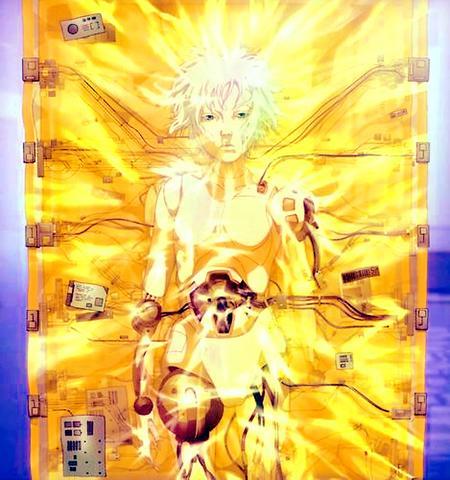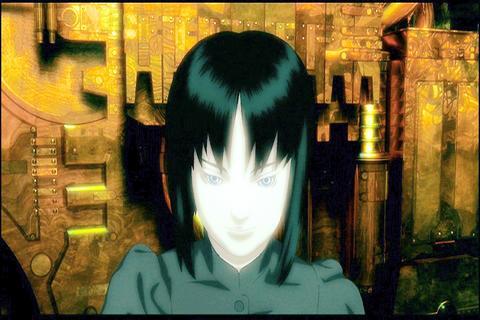Androids don't dream of electric sheep in Mamoru Oshii's hallucinatory meditation on life in the shadow of the machine world, Ghost in the Shell 2: Innocence. They dream of suicide, an unlikely act of violence that one android, or gynoid, a sexual pet with a tragic face and luridly flexible limbs, commits by clawing at its synthetic skin like a grieving widow.
In this plaintive, often stunningly beautiful anime, where sex dolls commit virtual seppuku against a swirl of film noir intrigue, philosophical speculation, eye-popping images and serious science-fiction cool, a toxic cloud hangs over all tomorrow's parties.

Written and directed by Oshii, the movie, which opens in Taiwan today, is a sequel to the Japanese filmmaker's 1995 anime, Ghost in the Shell, about a female detective who inhabits and then loses her artificial body.

PHOTOS COURTESY OF CROWN FILMS
Set in 2032, the new anime centers on her former colleague, the stone-faced cyborg Batou, a male cop in an unnamed government's antiterrorist division.
Called in to dispatch a gynoid gone amok, Batou enters with a ready gun and, in a photo-realist alley so authentically derelict that it's a surprise you can't smell it, comes face to face with a doll dressed in a peek-a-boo red kimono and a white gardenia. Push comes to catastrophic shove and, in time, what emerges is the familiar future-shock scenario in which machines seem more human than their human masters.
A study in earth tones and gum-shoe rectitude, Batou is a self-conscious cross between the detective played by Harrison Ford in Blade Runner and the runaway android played by Rutger Hauer. Drawn along the same solid lines as Hauer, Bateau comes clad in the classic world-weariness worn by Ford, one difference being that Oshii's tough guy keeps a basset hound. A floppy bundle of love and slobber, the dog is a link to the ghost (human identity) in Batou's machinery and, perhaps, as the hagiographic images of the hound suggest, something else.
Oshii squeezes charming laughs from Batou's relationship with the dog, but the hound's more essential function is to circle the film back to the fundamental question of what makes us human. Like Sean Young's replicant did with Ford's blade runner, the dog humanizes the hero and becomes the occasion for some philosophical riffing.
Although Oshii doesn't try to answer the question of existence, in between plot points that take Batou from a forensics lab to a yakuza den and rapacious doll company called Locus Solus (Latin for a solitary place), the filmmaker tosses in quotations from Descartes and Milton, nods to Jakob Grimm, Isaac Asimov and Jean-Luc Godard, lines from Psalm 139 and, most startlingly, references to the German artist and Surrealist fellow traveler, Hans Bellmer.
Inspired by Tales of Hoffman, Jacques Offenbach's opera about an automaton, Bellmer began constructing, then photographing, his fetishistic ball-joint dolls in the early 1930s. Machine-made rather than handcrafted, the dolls in Innocence are more streamlined than Bellmer's and significantly less perverse, but their ball-joints construction gives them a similar off-kilter, disturbing physiognomy.
The dolls in Innocence have bodies as bendable as that of a G.I. Joe toy, having been designed for sexual pleasure, while their faces remain frozen in Barbie-like supplication. Like many artists, Oshii clearly derives enjoyment from the image of the female form in all its mutations, but in this film that delight also comes with a little politics. Unlike Bellmer's dolls, Oshii's dolls sever their bonds and the occasional male head.
The bumps may be a function of the translation; whatever the case, they do nothing to diminish the delights of this exquisitely textured film. A seamless blend of old and new animation techniques, with the characters rendered in traditional 2D and the backgrounds in vivid 3D (computer generated imagery), Innocence doesn't just reveal a wealth of visual enchantments; it restates the case that there can and should be more to feature-length animations than cheap jokes, bathos and pandering. It also proves the point that 2D animation remains a vital technology.
But never mind the techno-babble. What matters most here isn't the number of gigabytes it took to make the feathers on a seagull look palpably real. It's the way the camera narrows in on the bird's eye as if Oshii believed the answers to the film's questions might be found in the natural world and its brutalized remnants, in that solitary place beyond the machines.
In one of the film's most hypnotically lovely set pieces, a kaleidoscopic cavalcade featuring enormous animal effigies, grimacing warriors and shimmering golden pagodas, he also suggests that the past may offer up yet other answers. In Innocence past and present, ghost and machine jostle alongside one another, while the mysteries of the universe, seen in the swirl of cream in a cup of coffee and spirals of flying gulls, continue.

On April 26, The Lancet published a letter from two doctors at Taichung-based China Medical University Hospital (CMUH) warning that “Taiwan’s Health Care System is on the Brink of Collapse.” The authors said that “Years of policy inaction and mismanagement of resources have led to the National Health Insurance system operating under unsustainable conditions.” The pushback was immediate. Errors in the paper were quickly identified and publicized, to discredit the authors (the hospital apologized). CNA reported that CMUH said the letter described Taiwan in 2021 as having 62 nurses per 10,000 people, when the correct number was 78 nurses per 10,000

As we live longer, our risk of cognitive impairment is increasing. How can we delay the onset of symptoms? Do we have to give up every indulgence or can small changes make a difference? We asked neurologists for tips on how to keep our brains healthy for life. TAKE CARE OF YOUR HEALTH “All of the sensible things that apply to bodily health apply to brain health,” says Suzanne O’Sullivan, a consultant in neurology at the National Hospital for Neurology and Neurosurgery in London, and the author of The Age of Diagnosis. “When you’re 20, you can get away with absolute

May 5 to May 11 What started out as friction between Taiwanese students at Taichung First High School and a Japanese head cook escalated dramatically over the first two weeks of May 1927. It began on April 30 when the cook’s wife knew that lotus starch used in that night’s dinner had rat feces in it, but failed to inform staff until the meal was already prepared. The students believed that her silence was intentional, and filed a complaint. The school’s Japanese administrators sided with the cook’s family, dismissing the students as troublemakers and clamping down on their freedoms — with

As Donald Trump’s executive order in March led to the shuttering of Voice of America (VOA) — the global broadcaster whose roots date back to the fight against Nazi propaganda — he quickly attracted support from figures not used to aligning themselves with any US administration. Trump had ordered the US Agency for Global Media, the federal agency that funds VOA and other groups promoting independent journalism overseas, to be “eliminated to the maximum extent consistent with applicable law.” The decision suddenly halted programming in 49 languages to more than 425 million people. In Moscow, Margarita Simonyan, the hardline editor-in-chief of the